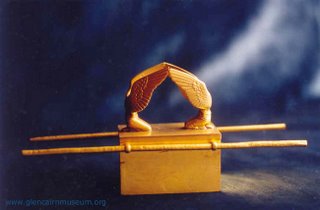Ark of the Covenant, Post 4

The symbolic association of God and the ark was developed in another direction by the theological tradition that we find in such Scriptures as Isaiah and the PT strand of the Pentateuch. This biblical theology finds it too anthropomorphic to think of God permanently seated upon the ark, dwelling in the temple as a human would live in a house. God is totally other than humanity.
God's appearances at the ark are episodic and transient. God speaks from between the cherub statues on the ark, not as a humanoid seated above them (e.g., Exod 25:22; 30:6, 36; Lev 16:2 PT). God’s appearing is marked by opaque clouds and burning flames. There is no visible image involved whatsoever (e.g., Lev 9:23–24; 10:2; 16:2 PT).
For visual art to represent the Holy, this theology claims, it must use negative means. A sense of ineffable mystery is best conveyed by pure space, vaulted absence, and eerie vacancy. The cherubim’s wings must frame such space.

As with yesterday's post, this symbolism is also attested by archaeology. Here is a tier from the Taanach cult-stand, showing two cherubim framing a completely empty space, representing God's mysterious, numinous otherness. They powerfully present us with a palpable emptiness. They direct our gaze past all human experience toward the Beyond.
0 Comments:
Post a Comment
<< Home